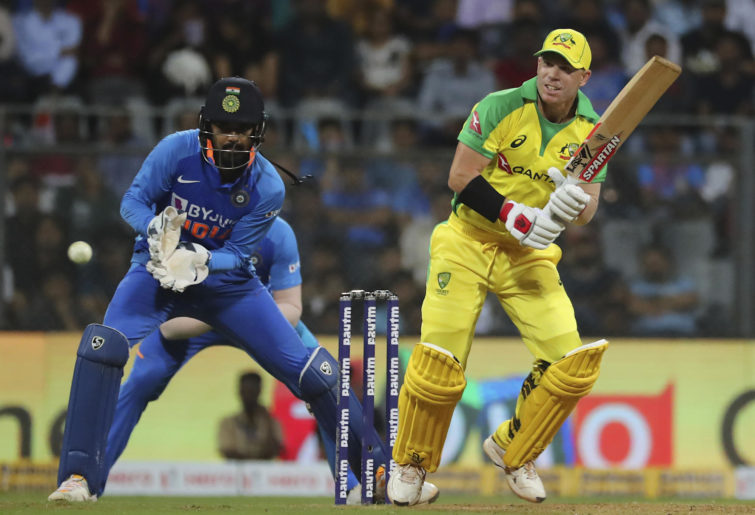When David Warner was banned for 12 months due to the ball-tampering scandal many people questioned if he would return the same cricketer. Well, he hasn’t. Warner’s even better now.
Certainly that is the case in T20s, the format he always looked primed to dominate yet never quite managed to master in his pre-ban career.
Warner’s debut international innings, more than 11 years ago, was an extraordinary 89 from 43 balls as he dismantled a full-strength South African T20 attack including peak Dale Steyn.
The powerful left hander immediately shaped up as a T20 gun, someone around whom Australia could build their team.
Yet over the following nine years, leading up to the sandpaper incident, Warner never again played a T20 innings of that quality for Australia.
Instead he became a superstar in Tests and ODIs, two formats which seemed to suit him less than T20s.
At the time he was banned, Warner had played 70 T20Is for Australia and owned the underwhelming record of 1,792 runs at 26, with a strike rate of 140. The veteran was in a deep form trough in T20Is, having averaged just 15 from his previous dozen innings.

David Warner bats against India. (AP Photo/Rafiq Maqbool)
With top order batsmen D’Arcy Short and Chris Lynn running amok in the BBL, and Aaron Finch on fire as an opener, it was no longer clear that Warner was in Australia’s best XI.
He looked burned out.
To an outsider, T20s seemed to be his lowest priority. If he was indeed thinking that way, he couldn’t have been blamed given the lack of importance Australia placed on T20s during the coaching reign of Darren Lehmann.
Again and again Australia rolled out understrength sides, paying scant respect to the format.
If he was burned out that also would have made sense. Prior to his ban, no Australian player shouldered a greater workload across all formats than Warner.
In the four years before that scandal, Warner played 130 matches for Australia across all formats – 44 Tests, 64 ODIs and 22 T20Is.
With Steve Smith rarely turning out in T20s in that period, Warner was the only player who was a fixture of all three Australian sides.
Warner (130 matches) and Smith (128) were miles ahead of the next busiest Australian internationals – Mitchell Starc (91), Glenn Maxwell (87) and Aaron Finch (86).
When you factor in the amount of travelling involved in international cricket, and Warner’s yearly appearances in the densely-packed IPL, that represents huge strain both physically and mentally.
Warner probably needed an extended rest. That’s just what he got, rather unexpectedly, in the form of a year-long ban from international cricket, the IPL and Australian domestic matches.
Over those 12 months he made just a few brief appearances in T20 leagues in Canada, Bangladesh and the Caribbean. When the ban ended he was fresh and hungry – rested like he hadn’t been for more than a decade.
First Warner began piling up runs in ODIs. He was the second-highest runscorer in the World Cup and, since his return, has hoarded 793 runs at 72 in that format.
Warner’s Test form has been as up-and-down as you’re ever likely to see from an Aussie batsman. A putrid Ashes series in the UK was followed by an incredible home summer, during which he made 786 runs at 131.

Steve Smith and David Warner. (Photo by PATRICK HAMILTON/AFP /AFP via Getty Images)
But it has been in T20s Warner has displayed the greatest improvement since his ban ended. In the past year, Warner has played 21 matches in the shortest format – nine for Australia and 12 in the IPL, by far the world’s best domestic league.
Incredibly, he has churned out 1,107 runs at 85. Such a return would be jaw-dropping in first-class or one day cricket.
In T20s it seems almost impossible.
So many risks are taken by aggressive T20 openers like Warner that they typically don’t get the luxury of boosting their average with lots of easy not outs. That’s one of the reasons his average of 85 is so difficult to fathom.
Perhaps for the first time since early in his career, Warner looks fully switched on in T20s. Aside from being fresh and ravenous for runs, two other factors are likely to be powering Warner.
Firstly, there is the looming presence of the T20 World Cup, the only limited overs tournament Australia never have won. Secondly there is the intense focus and high value being placed on T20s by coach Justin Langer.
No longer are T20s treated as a novelty, with second-string Australian XIs rolled out like they were regularly under Lehmann.
It was telling that, even after a hectic seven months involving a World Cup, an Ashes, five home Tests and a tour of India, Langer still didn’t rest any of his stars from the just-completed T20 series in SA. Winning is all that matters.
Not surprisingly, this newly-serious approach to T20s has greatly improved Australia’s performances in a format that was long a weakness. They are now the world’s number one T20 side and the firm favourites to win this year’s World Cup.
Amid this committed and successful environment, Warner is thriving. Some 11 years after that stunning international debut against the Proteas, he finally is doing what he appeared destined to – tearing the T20 format to shreds.






























































































